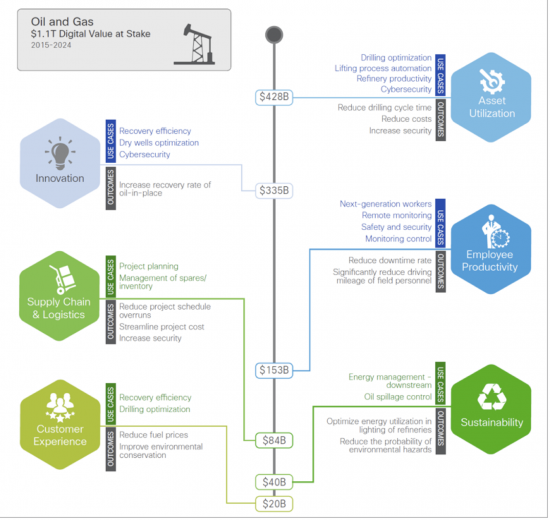Oil and gas executives are often asking these tough questions:
Where is the oil industry going?
How will it get there?
How soon does it need to get there?

I answered some of these points in a study I was proud to help create last year (A New Reality for Oil & Gas). I’m now pleased to announce a further updated report that looks at Digitization itself: what it means to customers, partners, and the industry.
The price of oil is riding a roller coaster. A few weeks ago, oil was close to $30 a barrel. This week, it is approaching $50. Who knows where it will go? One thing’s for certain – those companies and organizations who embrace the new world of digitization will thrive. The laggards will not! Our new report found that:
- Adoption of digital solutions is accelerating.
- Digitization is disrupting and redefining industries.
- Digital technologies are becoming more mature and pervasive.
- New digitally driven business models are changing the nature of competition.
- The consumer sector is now driving significant digital value.
One enormous challenge is the huge deluge of data when we look directly at the oil and gas industry. We found that the number one driver for digital investment is linking to data analytics for faster, better decision-making.
We also found that O&G companies can drive $86 billion in Digital Value by integrating cybersecurity directly into their digital platforms to reduce security breaches — and drive growth.

It doesn’t end there. I’ve often blogged about the adoption of next-generation worker technologies such as mobile collaboration, bring your own device (BYOD), and video collaboration. We found that these will generate $45 billion in Digital Value across the industry.
When Oil stood at $100 a barrel, many companies were doing very little to improve business efficiencies and were more interested in maintaining market share. Now cost savings and revenue growth are even bigger business imperatives, driven by new technology that allows digitization to becomes reality.
But how do you start?
It’s easy as 1-2-3:
1. Find out where you are on your digital transformation journey.
Some companies are looking for technologies to enable their transformation. Others are looking to enhance their customer experiences via digitization. Those in the know are already using the technologies to define their strategies with new business models.
2. Select digital use cases that deliver high-value business outcomes.
Here are some examples: simplifying and automating processes, empowering your work force to be more efficient and innovative, and getting close to your customers with more personalized experiences.
3. Develop digital business agility.
This hinges on three capabilities: Hyperawareness, informed decision-making, and fast execution. The first is about detecting changes and monitoring your business environment. The second is about having the ability to augment human judgment with superior data analytics throughout the organization and its processes. The third point is obvious, but is often neglected: carrying out plans quickly and effectively, and focusing on successful change management.
All of this needs the confident adoption of digitization technologies. In some cases (since budgets don’t always cooperate!), the investments aren’t entirely new. You can digitize by augmenting your secure and reliable network. If you chose Cisco for your network infrastructure, then digitization will be easier for you since you can build new capabilities into your existing network – including pervasive security and manageability as Cisco uses an architectural approach.
Let me leave you with a final thought from the revised report:
“When it comes to digital transformation, the real cost lies in not digitizing.”
Read more here: Where to Begin Your Journey to Digital Value in the Private Sector Economic Analysis
To find out how Cisco and our partners can help you, go to Connected Oil and Gas.
To get our blogs delivered straight to your inbox:

Back to School Reading. Peter’s correct that seasoned professionals use the summer to do some light homework before the autumn rush of a new fiscal year, new projects or new staff additions. It is important to have a governing framework in which to prioritize, start, stop, double-down or transfer work. This oil-and-gas framework can apply to other industries, commodities, services, infrastructures and architectures. Peter’s advice of a roadmap, use cases and planned execution are the best practices of experienced leaders. Plan the work and work the plan. Just in time for that end-of-year bonus or promotion.
Thanks Jonathon – not sure about “in time for the end-of-year bonus or promotion”, but you’re right about “plan the work, work the plan”- if you want to be successful. It was Winston Churchill, I think, who said: “Let our advance worrying become advance thinking and planning.” But he also mentored: “However beautiful the strategy, you should occasionally look at the results.”!
So true!
Digitization is no longer a nice to have / do, but a necessity for securing a business’s future.
Hi Peter Gutal. So true. And, if you’re the chap I saw in LinkedIn working for Telkom with all those Cisco certifications, you know what you’re talking about!